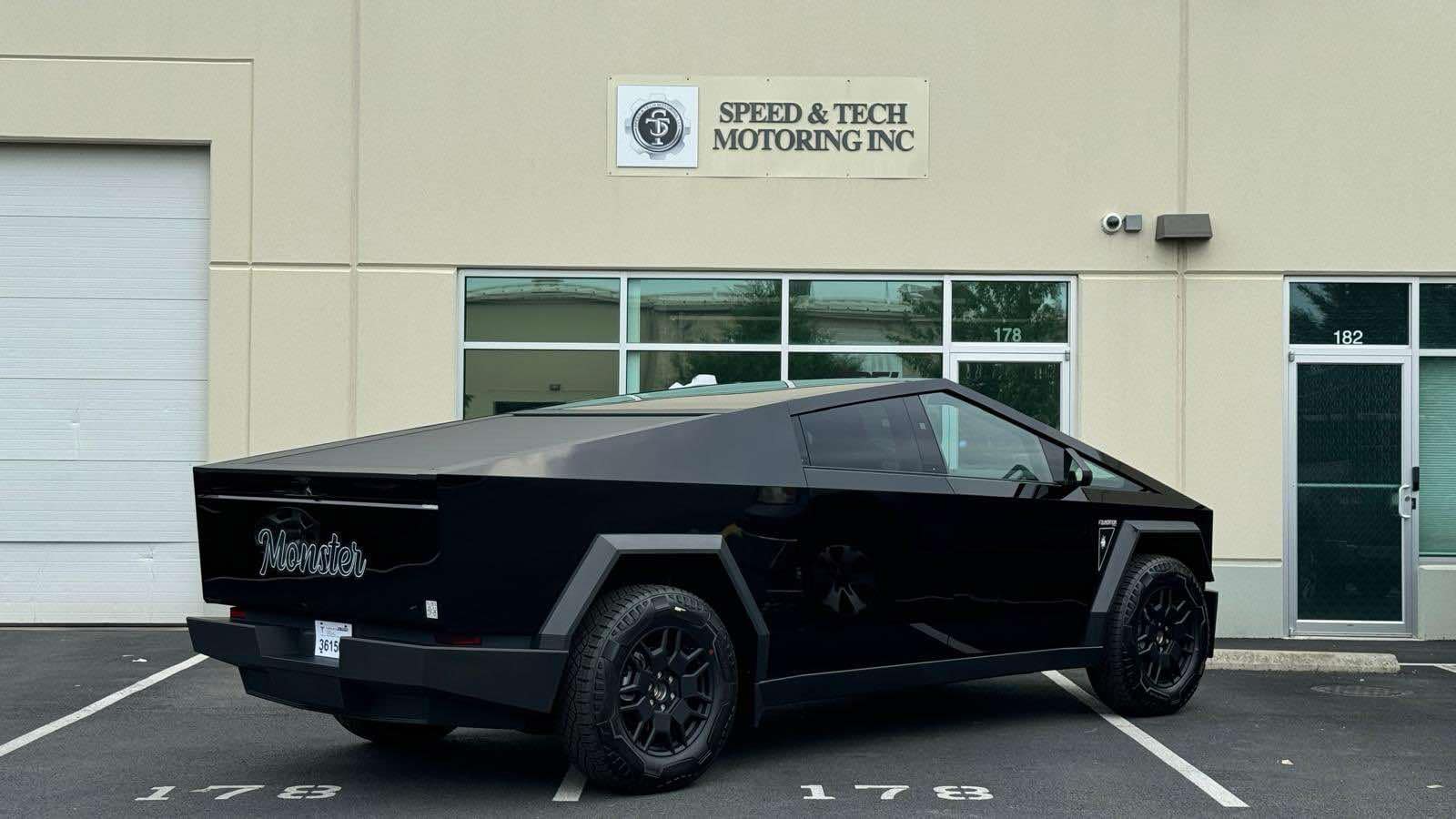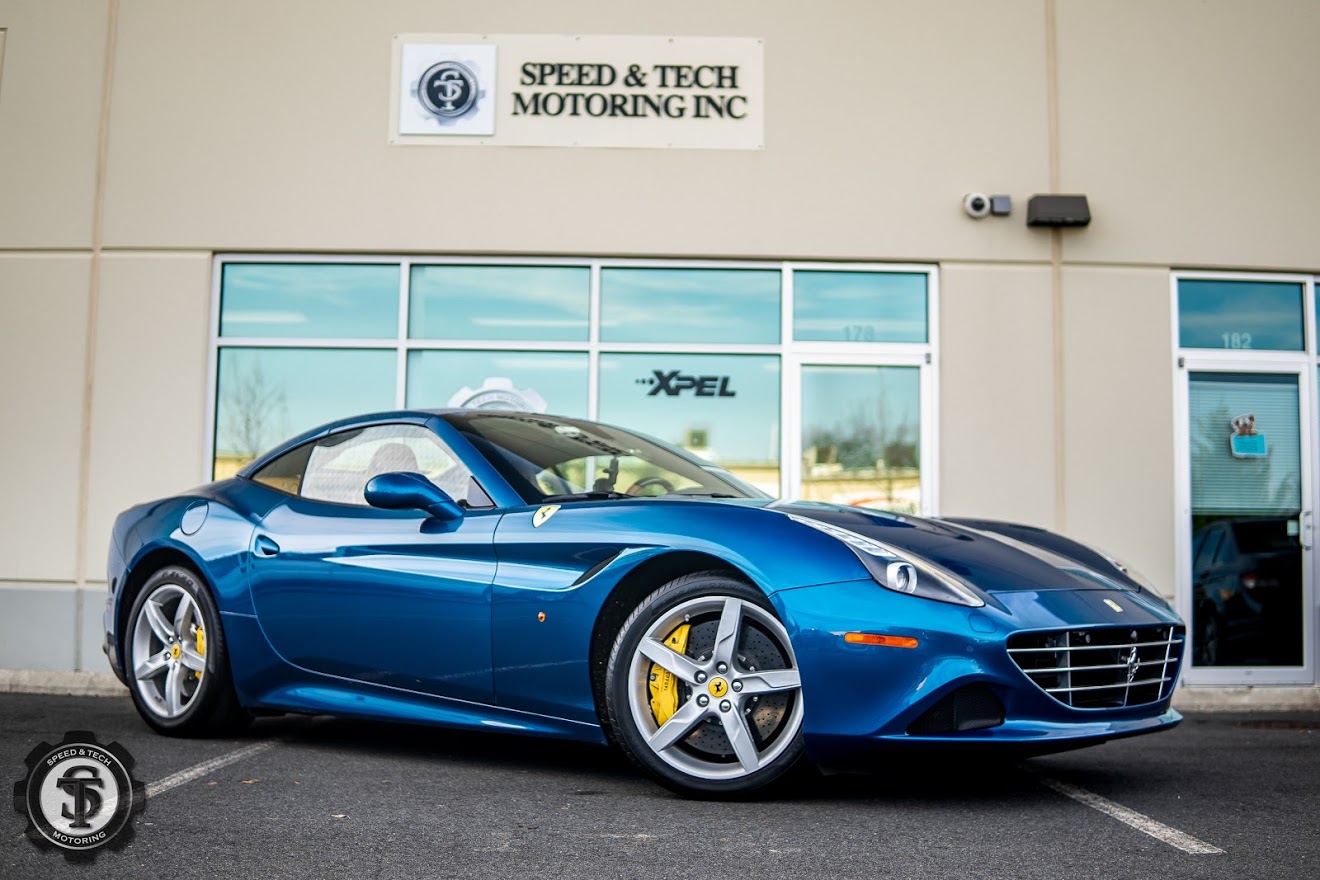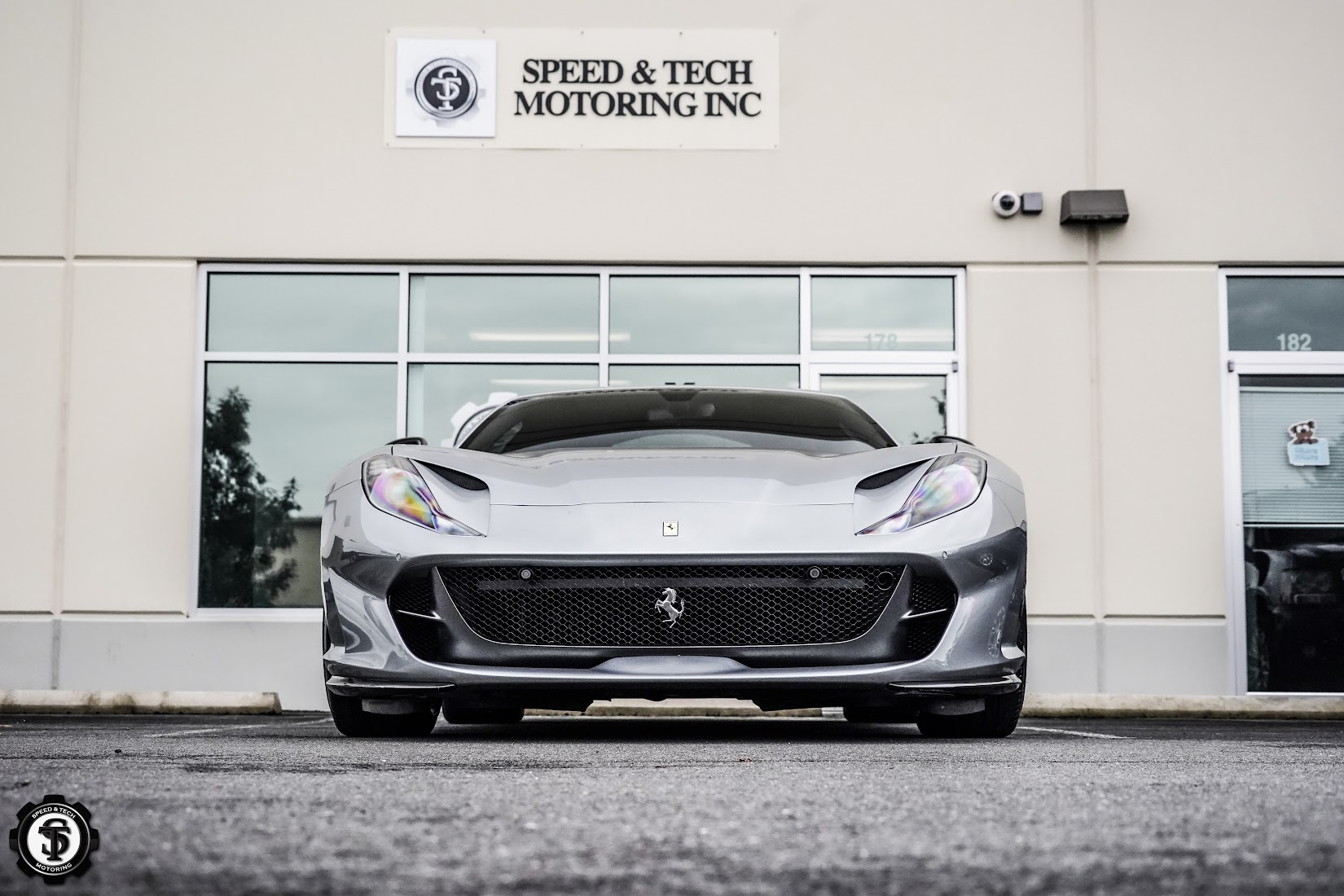Ultraviolet radiation streams through your vehicle’s windows every time you drive, silently causing damage you can’t immediately see. While you might notice the heat from sunlight, UV rays work invisibly, degrading your vehicle’s interior, threatening your skin health, and putting your passengers at risk for sun-related health issues. Understanding which window tinting technologies provide superior UV protection has become increasingly important as we spend more time in our vehicles and become more aware of sun damage consequences.
Modern window tinting has advanced dramatically in its ability to block harmful UV radiation. Not all films are created equal when it comes to UV protection, and the differences between technologies can be substantial. Some films block 99% or more of UV rays, while others provide only moderate protection. If you’re considering window tinting primarily for health and preservation benefits, knowing which technologies deliver the best UV defense helps you make an informed choice that truly protects what matters most.
Understanding UV Radiation and Its Impact
Before exploring specific window tinting technologies, it’s worth understanding what UV radiation actually is and why it poses such significant concerns for vehicle occupants and interiors.
What Makes UV Rays Harmful
Ultraviolet radiation exists on the electromagnetic spectrum between visible light and X-rays. Three types of UV radiation reach Earth’s surface: UVA, UVB, and UVC. Standard automotive glass blocks most UVB rays naturally, but UVA rays—which constitute about 95% of UV radiation reaching us—pass through untreated glass relatively easily. These UVA rays penetrate deeply into skin and cause long-term damage including premature aging, wrinkles, and increased skin cancer risk.
The cumulative nature of UV exposure makes it particularly insidious. You might not burn during a 30-minute commute, but those minutes add up to hours and eventually years of exposure. Studies have shown that drivers often develop more sun damage on the left side of their faces and arms in countries where people drive on the right side of the road, demonstrating how consistent vehicle-based UV exposure creates lasting effects.
How UV Exposure Affects Your Vehicle Interior
Beyond health concerns, UV radiation relentlessly attacks your vehicle’s interior materials. Leather seats crack and fade, fabric upholstery loses color and deteriorates, plastic dashboard components become brittle and discolored, and even metal trim can lose its finish. This degradation happens gradually but inevitably when UV rays penetrate your windows day after day.
The economic impact is significant. Replacing a faded leather interior can cost thousands of dollars, while a sun-damaged dashboard might require complete replacement. UV damage also directly affects resale value, as potential buyers immediately notice faded, cracked interiors and use this condition to negotiate lower prices. Effective UV protection through quality window tinting preserves both your investment and your vehicle’s long-term value.

The Connection Between Window Tinting and UV Protection
Window Tinting Sterling VA provides a defensive barrier between UV radiation and everything inside your vehicle, but the mechanism varies depending on the film technology employed.
How Tinting Films Block UV Radiation
Window tinting films block UV radiation through absorption, reflection, or a combination of both mechanisms. The specific particles, layers, and chemical compositions within different film types determine their UV-blocking capabilities. Some films use UV-absorbing chemicals that convert UV energy into harmless heat, while others incorporate particles that reflect UV wavelengths away before they can penetrate.
The thickness, density, and composition of these UV-blocking elements directly correlate with protection levels. Premium films engineered specifically for UV protection incorporate higher concentrations of blocking agents distributed throughout multiple layers, creating a more comprehensive barrier. This is why some films can achieve 99.9% UV rejection while others might only block 95-97%—a small percentage difference that translates to meaningful protection variations over time.
Ceramic Window Tinting for Maximum UV Defense
When it comes to UV protection, ceramic window tinting stands at the top of the performance hierarchy, delivering the most comprehensive defense available today.
Nano-Ceramic Particle Technology
Ceramic films incorporate non-metallic, non-conductive nanoparticles specifically engineered to interact with different wavelengths of electromagnetic radiation. These ceramic nanoparticles are distributed throughout the film in precise configurations that allow them to block UV radiation with exceptional efficiency. The nano-scale dimensions of these particles—measured in billionths of a meter—enable them to interfere with UV wavelengths while allowing visible light to pass through.
The manufacturing precision required to produce quality ceramic films contributes to their premium pricing, but this sophistication directly translates to superior UV protection. Unlike simpler film technologies that rely on dyes or basic absorption, ceramic particles actively target UV wavelengths through their molecular structure and arrangement within the film matrix.
UV Blocking Capabilities of Ceramic Films
Premium ceramic window tinting can block up to 99.9% of harmful UV radiation, representing the highest protection level currently available in automotive applications. This near-complete UV rejection means virtually no harmful rays reach your skin or your vehicle’s interior when you have quality ceramic films installed. The protection works across both UVA and UVB spectrums, providing comprehensive defense against all harmful ultraviolet wavelengths.
This exceptional performance isn’t just marketing hype—it’s measurable and verifiable through spectrophotometer testing. When you invest in ceramic films from reputable manufacturers, you’re getting documented UV protection that meets or exceeds the most stringent safety standards. Facilities like Speed & Tech Motoring can provide specifications and certifications that demonstrate exactly how much UV protection your chosen ceramic film provides.
Long-Term UV Protection Performance
Perhaps equally important as initial UV blocking capability is how well that protection holds up over time. Ceramic films maintain their UV rejection properties indefinitely without degradation. Unlike dyed films that fade and lose effectiveness, or metalized films that can deteriorate with exposure, ceramic nanoparticles remain stable and continue blocking UV radiation year after year.
This longevity means your investment in ceramic window tinting provides lasting protection throughout your vehicle’s lifetime. The UV defense you get on installation day is the same protection you’ll have five, ten, or fifteen years later. For people concerned about cumulative UV exposure and long-term interior preservation, this consistency makes ceramic films the clear choice.
Carbon Film Technology and UV Shielding
Carbon films represent an excellent middle-ground option, offering strong UV protection at a more accessible price point than ceramic technology.
Carbon Particle Construction
Carbon window tinting incorporates carbon particles distributed throughout the film structure. These particles interact with electromagnetic radiation including UV wavelengths, creating an effective barrier that blocks the majority of harmful rays. The molecular properties of carbon make it naturally effective at absorbing various forms of radiation, which is why carbon-based materials appear in many protective applications beyond automotive tinting.
The carbon particles in these films are larger than ceramic nanoparticles but still small enough to create a uniform, consistent appearance without clumping or visible texture. This construction method allows manufacturers to produce films that deliver solid performance without the complexity and cost of ceramic manufacturing processes.
UV Protection Levels in Carbon Films
Quality carbon films typically block 99% or more of UV radiation, providing excellent protection that approaches ceramic film performance at a lower cost. While that final 0.5-0.9% difference might seem negligible, carbon films still offer exceptional UV defense that dramatically reduces health risks and prevents interior damage.
For many vehicle owners, the UV protection provided by carbon films represents the sweet spot of value and performance. You’re getting UV blocking capabilities that far exceed basic dyed films and even surpass many metalized options, all while spending less than you would on premium ceramic technology. The slight performance gap compared to ceramic films is minimal in real-world application, making carbon an intelligent choice for UV-conscious buyers working within moderate budgets.

Metalized Films and UV Rejection
Metalized window tinting incorporates metallic particles that contribute to UV protection while primarily serving other functions like heat reflection and structural reinforcement.
Metallic Layer Properties
The microscopic metal particles embedded in metalized films naturally reflect various forms of electromagnetic radiation, including portions of the UV spectrum. This reflective property creates a protective barrier that bounces UV rays away from your vehicle rather than absorbing them. The specific metals used and their concentration within the film determine how effectively the film rejects UV radiation.
Metalized constructions typically incorporate multiple layers, with the metallic particles positioned to optimize various protective functions. While heat rejection often receives primary focus in metalized film design, UV blocking remains an important secondary benefit that these films deliver consistently.
UV Blocking Efficiency
Quality metalized films generally block 95-99% of UV radiation, providing good to excellent protection depending on the specific product and manufacturer. This protection level represents a significant improvement over untreated glass or basic dyed films, offering meaningful health and preservation benefits.
However, metalized films don’t quite match the UV rejection capabilities of premium ceramic or carbon options. The difference isn’t enormous, but for people specifically seeking maximum UV protection, metalized films rank slightly lower on the performance scale. They excel in other areas like heat rejection and durability, making them attractive for buyers prioritizing multiple benefits rather than UV protection alone.
Crystalline Films for Clear UV Protection
One of the most innovative developments in window tinting addresses a specific challenge: providing excellent UV protection without darkening windows.
Multi-Layer Technology Without Darkness
Crystalline films use sophisticated multi-layer constructions incorporating UV-blocking agents that work without pigmentation or darkness. These films achieve their protective properties through precisely engineered layers that selectively interact with different wavelengths. UV radiation gets blocked while visible light passes through with minimal interference, creating a nearly invisible film that still delivers substantial protection.
This technology particularly benefits people in regions with strict tinting laws or those who prefer the aesthetic of untreated glass. You maintain full visibility and the original appearance of your windows while gaining UV defense that wouldn’t exist otherwise.
UV Defense in Clear Applications
Quality crystalline films can block 95-99% of UV radiation while maintaining 90% or higher visible light transmission. This combination of transparency and protection was impossible with earlier tinting technologies and represents a significant advancement for UV-conscious vehicle owners who can’t or won’t use darker films.
Crystalline technology makes UV protection accessible for windshield applications, where most regions prohibit dark tinting. Applying crystalline film to your windshield provides UV defense for the entire front seating area, protecting skin and reducing dashboard degradation in the area most exposed to direct sunlight. This expanded coverage creates more comprehensive vehicle-wide protection than rear and side window tinting alone can achieve.
Comparing UV Protection Across Film Types
Understanding how different window tinting technologies stack up against each other helps you make informed decisions based on your specific priorities.
Performance Metrics That Matter
When comparing UV protection capabilities, the primary metric is UV rejection percentage, typically measured across the full UV spectrum (290-400 nanometers). Premium ceramic films lead this category at 99.9% rejection, followed closely by quality carbon films at 99%, then metalized films at 95-99%, and crystalline films at 95-99% depending on darkness level. Dyed films typically fall at the lower end, blocking 95-97% of UV radiation.
These percentages translate to meaningful differences in real-world protection. The gap between 95% and 99.9% UV blocking means nearly five times more UV exposure in the lower-performing option. Over years of daily driving, this difference compounds significantly in terms of both health exposure and interior degradation prevention.
Real-World UV Blocking Differences
In practical application, any quality window tinting film dramatically improves UV protection compared to untreated glass. Untreated automotive glass typically blocks only about 30% of UVA radiation, meaning 70% passes through to affect occupants and interiors. Even a dyed film blocking 95% of UV rays represents a huge improvement, reducing exposure by more than half compared to the untreated scenario.
However, when comparing top-performing technologies, the differences matter for people with specific concerns. Someone with skin sensitivity, a history of skin cancer, or conditions worsened by UV exposure benefits meaningfully from that extra 4-5% protection provided by ceramic over metalized films. Similarly, owners of luxury vehicles with premium leather interiors see measurably better preservation with maximum UV blocking.
Medical and Health Benefits of UV-Blocking Films
The health implications of UV protection extend well beyond simple comfort, touching on serious medical concerns that affect millions of people.
Skin Cancer Risk Reduction
Prolonged UV exposure directly links to increased skin cancer risk, including both melanoma and non-melanoma cancers. Studies published by dermatology organizations have documented higher rates of left-side facial skin cancers in countries where drivers sit on the left, demonstrating the connection between vehicle-based UV exposure and cancer development. Window tinting that blocks 99% or more of UV radiation significantly reduces this risk.
For people who spend substantial time driving—commuters, sales professionals, delivery drivers—quality window tinting becomes a legitimate health intervention. The cumulative protection over thousands of hours behind the wheel could genuinely reduce cancer risk. While window tinting shouldn’t replace sunscreen and other protective measures, it adds an important layer of passive protection that works automatically every time you’re in your vehicle.
Eye Health Protection
UV exposure also damages eyes, contributing to cataracts, macular degeneration, and other vision problems. Vehicle occupants face UV exposure not just from direct sunlight but also from reflection off other vehicles, roads, and buildings. This multi-directional exposure means UV rays can reach your eyes even when the sun isn’t directly visible.
Quality window tinting creates a protective environment that filters UV radiation before it reaches occupants’ eyes. This protection works constantly without requiring any action or awareness from vehicle occupants. Children are particularly vulnerable to UV eye damage, making comprehensive window tinting especially valuable for families who transport kids regularly.
Interior Preservation Through UV Filtering
Beyond health benefits, UV protection delivers substantial economic value by preserving your vehicle’s interior condition.
Preventing Upholstery Damage
Fabric and leather upholstery both degrade under UV exposure, though the mechanisms differ slightly. Fabric dyes break down, causing fading and discoloration. Leather dries out and loses its natural oils, leading to cracking, peeling, and complete deterioration of the surface. Quality window tinting that blocks 99% or more of UV radiation dramatically slows these processes.
The financial impact becomes clear when you consider replacement costs. Reupholstering a vehicle interior can easily cost several thousand dollars depending on the vehicle and material quality. Premium leather interiors in luxury vehicles might cost five thousand dollars or more to restore. When you compare these potential expenses to the cost of quality window tinting, the value proposition becomes obvious. The film pays for itself by preserving interior materials that would otherwise require expensive replacement or restoration.
Dashboard and Trim Protection
Dashboard materials—typically various plastics and polymers—become brittle and crack under sustained UV exposure. This degradation creates both aesthetic problems and functional issues as pieces break and structural integrity weakens. Trim pieces fade and discolor, creating an aged appearance that diminishes vehicle value.
Window tinting provides comprehensive protection for these components by filtering UV before it reaches interior surfaces. Vehicles with quality UV-blocking films maintain their dashboard condition far longer than untreated vehicles, preserving the like-new appearance that buyers value when you eventually sell or trade. This preservation directly translates to higher resale values and better negotiating positions.
Legal Standards and UV Protection Requirements
The window tinting industry operates within regulatory frameworks that ensure safety while allowing beneficial UV protection.
Industry Certification Standards
Reputable window tinting manufacturers submit their products for testing by independent laboratories that verify UV protection claims. These certifications provide documented proof that films perform as advertised. Organizations like the Skin Cancer Foundation evaluate and endorse window tinting products that meet stringent UV protection criteria, offering consumers confidence in their protective capabilities.
When selecting window tinting, looking for these certifications ensures you’re getting legitimate UV protection rather than marketing claims without substance. Professional installation facilities like Speed & Tech Motoring work with certified products and can provide documentation proving the UV blocking capabilities of the films they install. This transparency protects consumers and ensures they receive the health and preservation benefits they’re paying for.
Selecting Films Based on UV Protection Needs
Different situations call for different approaches to UV protection through window tinting.
Climate and Exposure Considerations
Vehicle owners in sunny climates with intense year-round UV exposure benefit most from maximum protection ceramic films. The constant sun exposure in places with 300+ sunny days annually creates cumulative UV damage that justifies investment in the highest-performing technology. Conversely, people in cloudier regions with less intense sun might find excellent protection in quality carbon or hybrid films that cost less while still dramatically improving UV defense compared to untreated glass.
Consider not just average sunshine but also altitude, as UV radiation intensity increases with elevation. Mountain residents face more intense UV exposure than coastal dwellers at the same latitude, making premium UV protection more valuable in high-altitude locations.
Vehicle Usage Patterns
Daily commuters accumulate UV exposure rapidly, making comprehensive protection valuable. If you spend an hour or more in your vehicle each day, you’re receiving substantial UV exposure over the course of a year. For these users, investing in ceramic films with 99.9% UV rejection makes practical health sense.
People who use vehicles primarily on weekends or for short trips accumulate less exposure, potentially making mid-tier carbon films with 99% UV blocking sufficient for their needs. The slightly lower protection level matters less when total exposure time is reduced.
Professional Installation and UV Performance
The best UV-blocking film in the world won’t perform properly if poorly installed, making professional installation crucial for achieving advertised protection levels.
Professional installers understand how to apply films without gaps, bubbles, or adhesion problems that could compromise UV protection. They work in controlled environments that prevent contamination and ensure complete coverage. The warranties provided by reputable installation facilities protect your investment and guarantee the UV protection you’re paying for.
Quality installation facilities also stay current with the latest film technologies and can guide you toward products that best match your UV protection priorities and budget. The expertise available at established businesses helps ensure you get appropriate recommendations rather than simply the most expensive option.
Speed & Tech Motoring Serving the Woodley North Community and Beyond in West Falls Church, VA
Speed & Tech Motoring is dedicated to serving the diverse needs of the local community of West Falls Church, VA, including individuals residing in neighborhood like Woodley North. With its convenient location near landmarks such as the National Funeral Home & National Memorial Park, Kingsley Commons Townhouses and major intersections like Lee Hwy (US-29) & Graham Rd and Arlington Blvd (US-50) & Gallows Rd (coordinates: 38.8742143243593, -77.21158545690683), we offer window tinting services.
Get Window Tinting Services at Woodley North Now
Navigate from Woodley North to Speed & Tech Motoring Now
How Window Tinting Films Effectively Block Harmful Ultraviolet Rays?
- UV Blocking Efficiency of Window Tint Films:
- Blocks over 99% of UVA and UVB rays (Skin Cancer Foundation, 2025)
- Ceramic and carbon films block up to 99% of harmful UV radiation (ClearPro, 2024)
- Standard automotive laminated windshields block about 98% of UVA rays
- Tempered side and rear windows can transmit up to 79% of UVA without tint (Cancer Council Australia, 2025)
- Applying clear or tinted UV window films reduces UV transmission through tempered glass by over 99%
- UV Exposure Without Tinting:
- Side windows allow significant UVA penetration, contributing to up to 40% of UV exposure for drivers (ClearPro)
- Prolonged exposure through untinted windows linked to asymmetrical skin damage (e.g., truck driver’s left face side aged from sun exposure)
- Additional Benefits:
- Window films also reduce solar heat by up to 60% (3M, 2025)
- Protect vehicle interiors from fading and deterioration caused by UV rays
Visual suggestion: A bar chart comparing UV transmission percentages:
- Laminated windshield (2% UV transmission)
- Untinted tempered side window (up to 79% UV transmission)
- Tempered side window + UV film (<1% UV transmission)
- Ceramic/carbon tint film UV blocking (~99%)

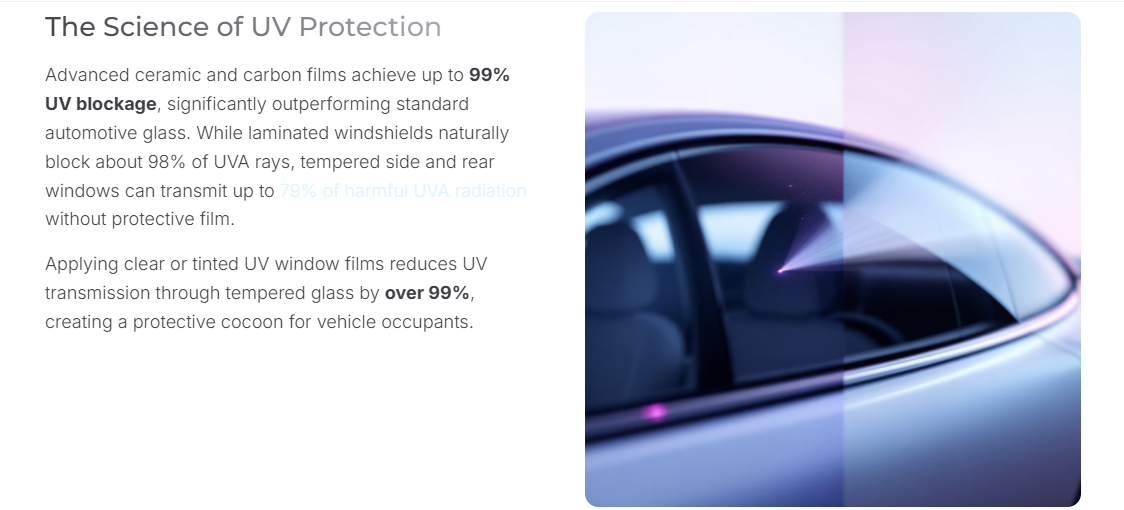
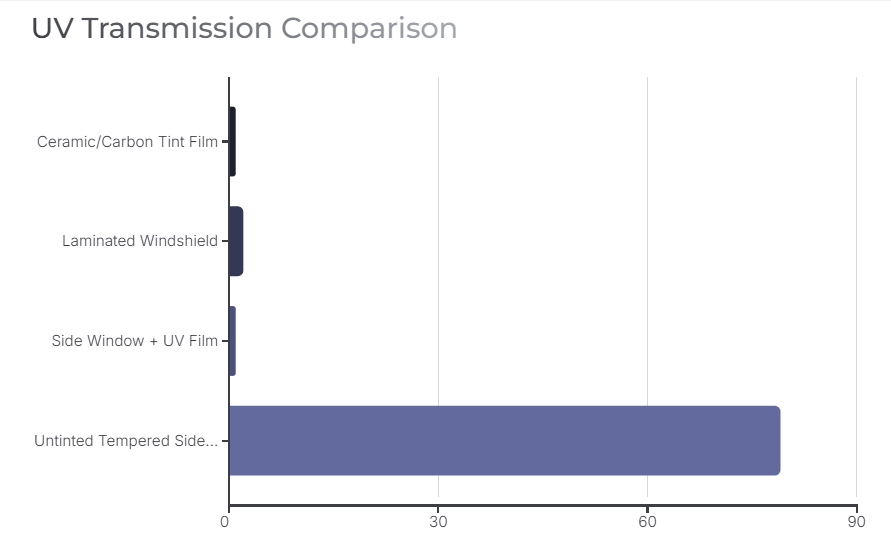
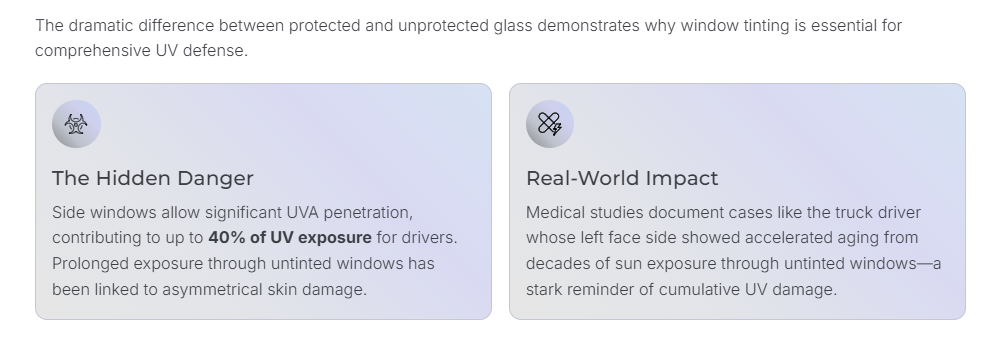
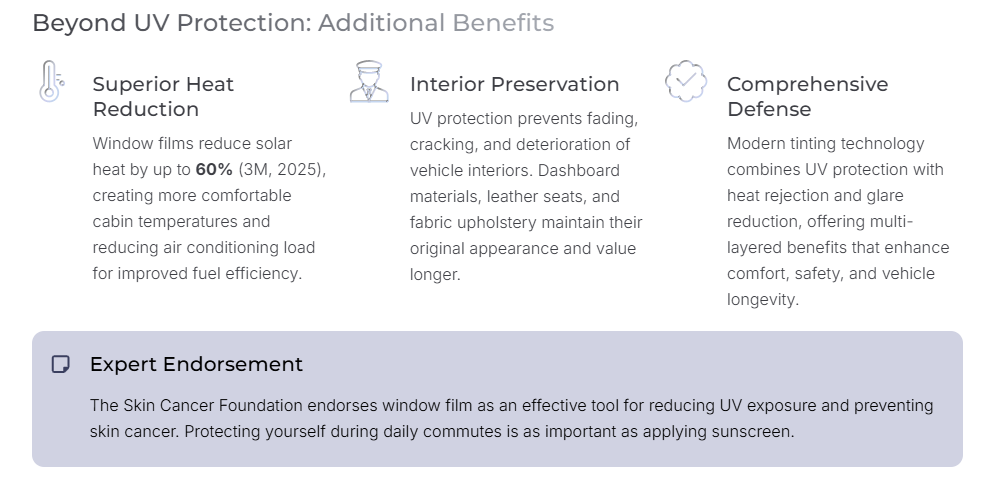
Sources: Skin Cancer Foundation, ClearPro, Cancer Council Australia, 3M (2025)
When it comes to UV protection, not all window tinting technologies perform equally. Ceramic films lead the category with up to 99.9% UV rejection, offering maximum protection for health and interior preservation. Carbon films provide excellent 99% UV blocking at more accessible prices, delivering outstanding value for most users. Metalized and crystalline films offer good to excellent protection at 95-99% depending on specific products, serving well in appropriate applications. Even basic dyed films dramatically improve UV protection compared to untreated glass, though they can’t match the performance of advanced technologies.
Your ideal choice depends on your specific situation, priorities, and budget. People with heightened skin sensitivity, medical conditions affected by UV exposure, or premium vehicle interiors benefit most from maximum-protection ceramic films. Daily commuters accumulating substantial vehicle time should prioritize higher UV blocking levels. Vehicle owners seeking balanced performance and value find excellent options in carbon technology. Understanding these technologies empowers you to make informed decisions that truly protect your health, your passengers, and your automotive investment for years to come.
FAQs
Which window tinting technology provides the absolute best UV protection available today?
Ceramic window tinting delivers the highest UV protection currently available, blocking up to 99.9% of harmful UV radiation. The nano-ceramic particles in these films are specifically engineered to reject UV wavelengths while maintaining clarity and not interfering with electronic signals. This represents near-complete UV defense that protects both health and vehicle interiors better than any other film technology currently on the market.
How much UV radiation does untreated automotive glass actually block?
Standard automotive glass blocks most UVB radiation naturally but allows approximately 70% of UVA radiation to pass through untreated. Since UVA constitutes about 95% of UV radiation reaching Earth’s surface and penetrates more deeply into skin, this represents significant exposure. Side and rear windows typically offer even less UV protection than windshields, making window tinting particularly valuable for comprehensive vehicle-wide UV defense.
Can clear window films really provide meaningful UV protection?
Yes, crystalline and other clear film technologies can block 95-99% of UV radiation while maintaining 90% or higher visible light transmission. These films use multi-layer constructions with UV-absorbing agents that work without pigmentation, making them ideal for windshield applications or regions with strict tinting laws. While they may not quite match the 99.9% rejection of premium ceramic films, they still provide excellent UV defense without darkness.
Does window tinting UV protection decrease over time?
This depends entirely on the film type. Dyed films can lose UV protection capability as dyes fade over 3-5 years. Metalized films maintain relatively stable UV blocking for 5-7 years. Carbon films stay consistent for 7-10 years. Ceramic films maintain their UV rejection properties indefinitely without degradation, providing the same protection after a decade as they did on installation day. This longevity makes premium films more cost-effective over vehicle ownership periods.
How much does premium UV-blocking window tinting typically cost compared to basic films?
Basic dyed films might cost $150-300 for a full vehicle, while premium ceramic films with maximum UV protection typically range from $400-800 or more depending on vehicle size and film brand. Carbon films usually fall in the $300-500 range. While the upfront cost difference seems substantial, consider that ceramic films last the vehicle’s lifetime without replacement, provide superior interior preservation worth thousands in avoided damage, and offer meaningful health protection. The total value often favors premium options despite higher initial investment.
Our Other Blog Posts Related Window Tinting
How Window Tinting Films Differ And Their Unique Benefits
How Window Tinting Improves Privacy While Maintaining Clear Views
How Window Tinting Protect Car Upholstery And Interior Quality
How Long Does Window Tinting Last? Expert Tips to Extend Its Life

